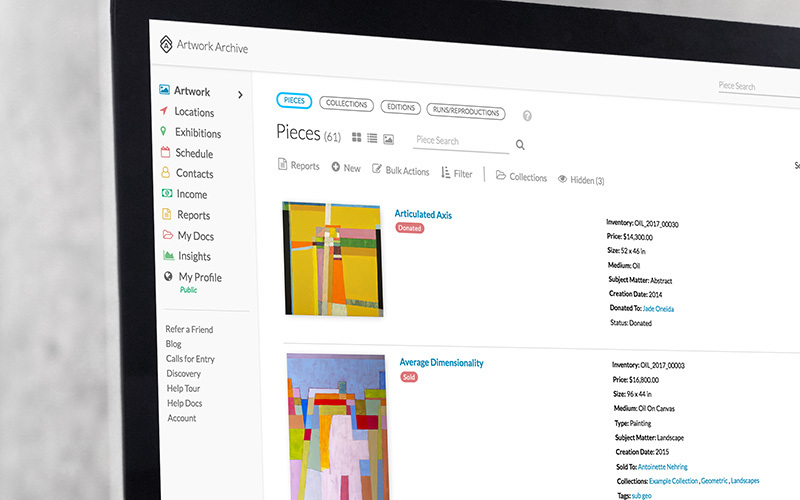
It’s easy to always be focused on the future of your work as an artist.
 |
Katie Carey is a ceramic artist, writer, and strategist out of Denver, Colorado. She joined the Artwork Archive team after the platform transformed her own art practice. |
I, for one, am guilty of moving on from a current project without so much as even photographing the work before sending it off to its new home, and then I’m on to the next exciting project.
However, it recently hit me that perhaps just as important as the physical work itself is the documentation of that work. I realized that, no matter how good the work might be, it will not live on if it's not documented well and archived securely.
I always assumed that I would be making work indefinitely and would be capable of making similar work if I wanted to recreate an unphotographed work. It's all too easy to assume that the gallery sites that host photographs of installations of my work would still be around if sometime down the line I wanted to use them for my own portfolio. Instagram and other social media platforms give you a false sense of security that they will always be there to pull images from in the future.
With my website on auto-pilot, I fell into a comfortable naivety that the internet is a permanent place of archival information.
However, that’s far from the truth.
Websites crash, updates render your images useless, hard drives fail, external drives get corrupted, water gets spilled on keyboards, and for me, personally, my hard drive got immediately fried when I plugged it into an outlet of an old Victorian house while on vacation.
Right at that moment, all the things I wanted to apply to, or simply even remember in the future flashed before my eyes. How would I build back up an entire portfolio that was sold if I wanted to apply for a residency this summer? What if I wanted to go back to grad school and I didn’t have any work to show?
What if, most simply—but also most deeply— I just wanted to look back over my artistic development in a few years and see the progression of my body of work?
I decided then that if for whatever miracle, I could get the good people at Apple to recover my data, I would take a more active role in documenting and archiving my artworks.
Thankfully, after many tears and a few different trips to the Apple store, I miraculously had my hard drive recovered and immediately began setting out on finding the most simple and also most secure way to digitally document my artwork.
I figured that if I could put in 30 minutes of work upfront finding an art inventory system that works for me, I would save the month or so that I spent stressing out over whether or not they would be able to recover my data.
I developed a simple system for myself that helps me to both archive and keep track of my artworks.
Most surprising, however, I found that I actually started to enjoy the process of documenting my work. It allowed me to see my work in a new light, value my current projects, see my progress more clearly, and gain peace of mind in the direction of my art practice.
I am now able to see the full scope of the last ten years of creating work and feel a type of satisfaction when looking through my inventory catalog. Moreover, it helps me stay organized in day-to-day life so that I don’t have to stress about the small things. I know where my artworks are located, who bought them, where they need to be in a month for a show, and when I need to invoice or follow up on an invoice.
If you asked anyone I know, they would laugh if you told them that I enjoy any type of activity that includes getting organized. I’m the type of person that leaves old coffee mugs in my car and tried and failed the Marie Kondo method in the span of a week. My clothes remain in an angry lump on my couch instead of rolled neatly and happily in my drawers.
But, my journey into documenting my artwork has stuck around—and I’m here to tell the tale. Let’s jump into what I learned along the way.
Before you begin the process
There are many different reasons to archive your artwork. Perhaps you want to make it easier to update your portfolio. Perhaps you want to be able to pull your updated resume, CV and press for an upcoming grant application at a moment’s notice.
Maybe your portfolio has become outdated and you are searching for a way to keep it up-to-date in order to highlight your newest works and biggest achievements to date with potential collectors and clients.
Perhaps you are looking for a secure way to digitally store your inventory of artworks and ensure your artistic legacy for years to come.
Personally, my reason for starting a digital archive of my artwork was two-fold. I wanted a secure way to back up my artworks with all the details about them, their exhibition history, and all related sales information and images. It wasn’t enough for me to have them in GDrive or Excel (though this is a good start). I was looking for a way to build a full picture of the history of my artwork and be able to access that information as quickly as possible without digging through thousands of folders.
The second reason turned out to be more of a comprehensive way for me to gain insights into my creative trajectory as an artist. I quickly saw how valuable it was to be able to organize my works and get a full picture of my art career from the start. I could see where certain creative evolutions took place, what types of artworks and themes sold the best, what geographical regions were the most profitable for my artwork. This information helped spark new strategic ideas for both the direction of my own art practice and the business aspect of my artwork.
Whatever the reason, it’s important to define your “why” before you begin to help act as your guiding North Star as you go through the archiving process.

Getting started: What information to start gathering
If you are like most artists, you most likely have bits and pieces of this information all over the place. You have information on your website, at your galleries, in past publications, on your social media, and in your own records.
This is what we are trying to solve, but it is also a great starting point.
Take a look at your CV and use the exhibition history section as a jumping-off point. Then, create a running list of works that you want to inventory. Some artists choose to work chronologically from the most recent artworks, for example, as this information is the most top of mind.
Here is the information that I started with for each artwork:
- Title of the artwork
- The date it was created
- The medium/mediums used
- Dimensions of the artwork
- The price of the artwork
- Any exhibitions that it was accepted into
- Any galleries in which the artwork showed
- If the artwork was sold and who it sold to
- The high-resolution image of the artwork
- Any detail images of the artwork
From there I started to fill in more information once I got the framework in place.
First steps: Choose the right tools to archive your work
The tools you choose to archive your work will determine the scope of your archiving project.
I decided to go with Artwork Archive as it was highly recommended by other artists, could capture the breadth of information I was looking to archive, was cloud-based, had neat “extras” like invoicing, a public profile option, and a range of professional pre-formatted reports–and on top of it all, it was the most affordable option.
I started with all of the works I already had digital photos of, either on a website, on my phone, or professional photos. I started with my most recent work (mainly because I was still excited about them). Made a master desktop folder of all the images I had and, honestly, the rest was pretty straightforward.
After uploading a bulk of my images, I then went back and recorded all the information like title, price, and medium alongside the image.
Adding artworks to the database is easy. All the fields I filled in for medium, for example, were “remembered” so that I can now filter, sort, and search for those works within the database. It’s an incredible way to quickly pull up very specific pieces within a large body of work without remembering the exact name of the work. Or, if I want to create a price list for a customer that is interested only in porcelain works with blue and gold patterning, for example, I could quickly pull up all of my works that fit that category and within a few clicks generate a report for them with the thumbnails of those works along with all their information and prices.
One of my favorite aspects of the platform is that the database is so visual—because, well, artists are very visual beings!
I can easily scan all the works I have in my inventory or in certain galleries or retail locations. I don’t have to scan through loads of text or spreadsheets or click in and out of a pile of folders.

Second step: Getting all the details right
Beyond documenting my artworks, I was looking for an inventory program that could build a holistic picture of my archive with a dynamic database. What I mean by that is that I wanted to be able to tie artwork records to contacts, documents, exhibitions etc. instead of living statically in a list.
Have you ever found yourself panicked in the middle of the night asking yourself:
- Did I already commit this painting to an exhibition in September?
- Have I submitted to this exhibition before?
- Who did I sell that painting to last year?
- How much did the frame cost?
- What gallery is performing best for me?
- What body of work of mine is the most profitable?
- What were the dimensions of the painting that is currently on loan?
- Will this group of artworks work together for as a solo show?
I can now easily find the answers to all of these questions within a few seconds instead of fueling my insomnia with unanswered questions plaguing me.
I got to this point by adding the following information into my archive after getting my artworks uploaded:
The locations where my artworks have shown
If some of your works are at a gallery or were at a gallery in the past, you can create a ‘Location’. When you assign an artwork to a location, you will start building a “location history” for that artwork, which helps with your catalog raisonne.
I also like this feature for knowing when I need to pick my works back up from the gallery, what works sold from the gallery, and for creating quick consignment reports for the gallery.
My art business contacts (collectors, gallerists, models, designers)
Adding my contacts in help to easily keep track of the key people associated with my art business such as buyers and galleries. I, admittedly, am not great at following up with clients after an initial sale, but it’s so important.
Your current client list is a huge source for potential sales. It’s essential, I’m learning, to have their contact information and some past notes about what they previously purchased available wherever and whenever I need to access it.
Exhibitions I have entered
If you enter or participate in a lot of exhibitions, it’s crucial to keep track of where your artwork is coming and where it is going at any time. “Exhibitions” is a way for you to track information that corresponds to each competition/exhibition you've entered. You can record information including Pieces Submitted, Submission Deadline, Pieces Accepted, Competition Date, Notification Date, and Awards.
It’s been a useful tool for me to see what pieces are getting accepted regularly and make some conclusions about patterns I see.
Any editioned artworks/prints of my original works
Editioned work is a particularly sticky wicket to try and archive without a dedicated tool. There are too many details, too many moving parts, and just too much in general. I was thrilled to see that Artwork Archive built out a comprehensive way to track original editions and reproduction prints within the archive.
Some of the financials
Because I’m more interested in numbers than most artists, I love knowing where every dollar of my art business is coming in from and where every dollar is going. The “income” feature has been helping me get an accurate picture of the business side of things.
You can tie your expense and revenue items to clients and get insights into your finances.
Most importantly, make archiving part of your process
Habits are established through repetition.
Make archiving a part of your creative process and you will thank yourself in the long run. When you finish an artwork, add photographing the work and recording the artwork details in your archive to your final steps before you are truly finished and you post the final product to Instagram.

Get your own archive set up
You can sign up for a free 14-day trial of Artwork Archive to get your own archive started. There are plans for all levels of artists (my one regret: I wish I had started earlier!).
Plans start at $6/month for 50 archived artworks. Another plus of the platform is that you can upload extremely high-resolution images (30mb) and up to 10 images per artwork record.
The next level up allows for 500 archived artworks and the highest plan, the master account, is an unlimed plan.






